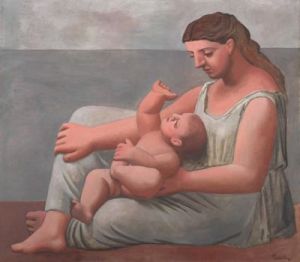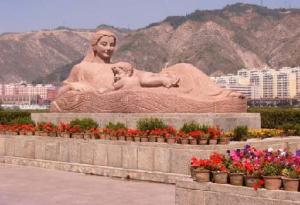Next week, I should be making a business trip to Chicago. I thought that I can visit one of my favorite museums, the Art Institute of Chicago again. Unfortunately, due to some urgent business at work, I cancelled my trip. The Art Institute of Chicago has many of my favorite art works, including:
Gustave Caillebotte, Paris Street; Rainy Day,1876-1877
Georges-Pierre Seurat, Sunday Afternoon on the Island of La Grande Jatte 1884–1886
Pablo Picasso, The Old Guitarist, 1903
Today, I would like to refer to another painting which is very interesting to me. It is Picasso’s Mother and Child.
http://www.artic.edu/aic/collections/exhibitions/modernwing/artwork/109275
Pablo Picasso
Spanish, worked in France, 1881–1973
Mother and Child, 1921
The Art Institute of Chicago
Here’s an interesting analysis of this painting by Mike Freeman’s Analysis of Picasso’s Mother and Child Painting
“Upon investigating the unusual life of Pablo Picasso in an attempt to familiarize myself with his painting titled Mother and Child (1921), I feel that this painting represents the false depiction of a happy family despite true distant feelings. A paragraph I read during some research suggested that one of Picasso’s Mother and Child paintings had undergone x-ray analysis. Apparently, a shadow of Picasso’s arm can be seen in the painting, hence the reason the child is reaching upwards into the air. Originally, Picasso had painted himself into the painting to depict a perfect family life, however upon ever mounting arguments held between himself and his wife Olga, the presumed mother in the painting, Picasso chose to remove himself completely from the artwork. This theory, if true, and based on a seemingly credible source, supports my theory about Picasso’s separation from not only his wife, but his own son. Throughout the biographies I encountered about Pablo, accounts of his life share the same idea that Picasso was extremely secluded from his children, most talked about in particular his son Paulo, who is believed to be the child in the painting. Paulo was born shortly before this painting was created. Removing himself from the painting, symbolizes Picasso’s desire to remove himself from his current life situation, showing his displeasure for his wife and son. Despite his true feelings towards his family, he still paints a typical “happy family” portrait. The only difference with the final product was the exclusion of himself. Often, it is suggested that Picasso, like most artists, paint not only on what they observe, but also their deepest desires and inner feelings. This painting, at first glance from the untrained eye of an average museum traveler, depicts a seemingly love filled, nurturing portrait of a mother and her son, seemingly part of a happy family. Little do those people know the awful, heart wrenching truth laced deep within the paint that was expertly splashed in malice and sorrow to create a masterpiece.”
I am not surprised at this analysis. After all Picasso had had so many women in his life. He removed himself from the painting. What does it symbolize?
This painting was painted in 1921, in his Neo-Classicism period (1920-30). It shows heavily built sculpture-like women. The famous one in this period is at MOMA: “Three Women at the Spring” 1921.
To understand Picasso’s style in this period, I found this excerpt very helpful as it talks about the “the three women at the spring”:
http://www.moma.org/collection/object.php?object_id=79762
“Curator, Kirk Varnedoe: When you look at Picasso’s Three Women at the Spring this represents the embodiment of what one calls the return to order—the idea that after World War I, French society wanted to reestablish its roots with the grand tradition and a kind of solid, reassuring, sculptural vision of the human figure rooted in classicism. It was an art of reassurance, of rebounding after the experimentation of the teens. And yet when you look at this picture, it’s not really a conservative picture—the tubular nature of the arms, the large abstract rhythms of the figures are very much a legacy of his more radical work.
Remember again that this is painted exactly in the same summer that he paints The Three Musicians. Unlike Matisse, Picasso is happy working in two extremes virtually simultaneously, painting a picture of strong Cubist abstraction on the one hand,and seemingly full-bodied sculptural realism on the other.”
I saw this painting for the first time in the Art Institute of Chicago around 2003. I was impressed by the different styles of Picasso at the same period of time. Few Years later, I took a trip to the Silk Road in China with family and friends. At the end of the trip, we went to Lanzhou and visited the Bund of the Yellow River to see this beautiful sculpture named the Yellow River Mother. This is the picture from a tourist website:
http://www.greatwalldiscovery.com/lanzhou/discovery.html
http://scenery.cultural-china.com/en/148Scenery2849.html
“This sculpture is the best of its kind in China. The whole sculpture contains that of a mother and a baby. The mother with long hair, slim figure, lying on the undulated water looks happy and kind. On her breast she holds a small kid who bears naive smile. The sculpture connotes that the Yellow River has nourished generations of Chinese.”
The Mother symbolizes the Yellow River which is the cradle of the Chinese civilization. What is special about this Mother sculpture are her facial features. Does she look like most Chinese Han people? No, because the people in Lanzhou are the Hui minorities who have some western facial features . Let us find out where is Lanzhou and what is its significance in formulating the cultures of this part of the world.
http://www.travelchinaguide.com/cityguides/gansu/lanzhou/
“Lanzhou is the capital city of Gansu Province in northwest China. The Yellow River runs through the city, ensuring rich crops of many juicy and fragrant fruits. The city is the transportation and telecommunication center of the region. Covering an area of 1631.6 square kilometers (629.96 square miles), Lanzhou used to be a key point on the ancient Silk Road. Today, It is a hub of the Silk Road Tourism Ring,”
Here’s another informative article describing the people of Lanzhou, their religion, traditions and customs::
“Lanzhou has certainly changed since the first foreign visitors started coming here 100 years ago. But the city retains its distinct character due to its location along a narrow valley astride the Yellow River, and the visible Muslim culture. The river is never far away, and the hills to the north and south offer spectacular views from hilltop tea gardens. Looking down on the city you’ll be sure to spot some mosques. The Hui Muslim population is small but very visible. There are qīngzhēn (清真) restaurants on every street (not all noodles, by the way), and if you are nearby a mosque at prayer time, you’ll hear the call to prayer.”
We now know that the sculpture reflects the Hui minority ethnic group. When I saw this Yellow River Mother sculpture, I immediately thought about the Picasso’s painting of Mother and Child. Do you think there are some similarities between the two? As artists’ inspire each other, it is possible that the sculptor who made this sculpture 65 years later may have been inspired by Picasso. The sculpture is the work of a famous female Gansu sculptor He E. Actually He and Picasso have very different styles. It just fascinated me when I saw the big Mother sculpture in Lanzhou because it was speaking to me. It spoke of the love of the mother for the child. I hope you do feel the same way.
Which one do you like more? I like the Yellow River Mother more because of her smile and its beautiful face. In Picasso’s painting, the mother seems to have some hidden sorrow on her facial expression and not as beautiful. Indeed none of the women drawn by Picasso is like a regular beauty. Both pieces do have a similar theme: the love of the mother for her child.
What do you think? I’d love to her from you!




Interesting, thanks for sharing this. I think both are remarkable pieces of art. Well, I personally like western sculptures a bit more, which provide me with more imaginations; I think the face of the mother is like Buddha.
LikeLike
I think she is not like Buddha, as the religion the people in this region observe is Islam. Islamic art does not have figures or people images like the other art. Buddha images usually reflect the local people’s images. I can write another post in this. Recently I didn’t have any Buddha pix of my own. I will keep this in mind.
Perhaps I am wrong about this mother image. Let me find out more. Thanks for raising a good question .
LikeLike
Well, I had to make a tough choice : Hey, just want to let you know that I will not continue my blog for a while, since I will be busy at some music projects that I’ve signed up, well, that’s life and one does not have all the time for everything in life …. I wish you all the happiness along the blogging journey and keep up with good posts. ~ Musiqdragonfly
LikeLike
Hi Sarah: I am sure we will all miss you and your blog. I was writing something more on the Yellow River and found your remarks. I wish you all the best in your music projects. Perhaps one day you will post your music performance on You-Tube. Let us know.
Sincererly,
Denise
LikeLike
thank you, not until summer will I finish these projects, but will check out WP posts whenever I have time…. bye-for-now.
LikeLike
[…] http://speakingabosuttravel.wordpress.com/2013/03/09/the-yellow-river-mother-cco,-in-lanzhou-china-a… […]
LikeLike